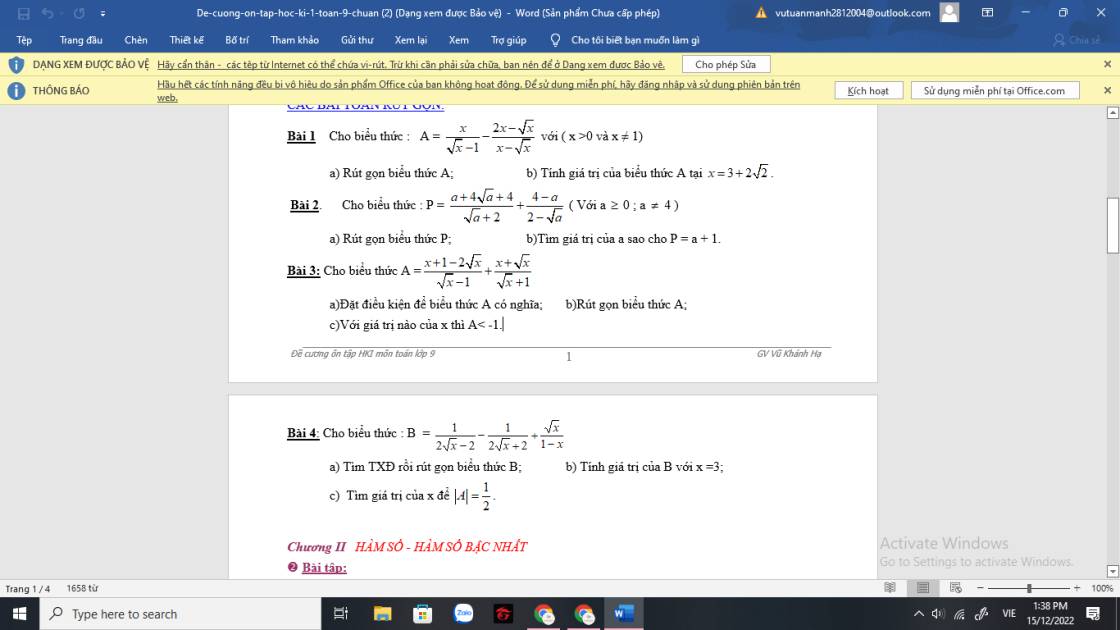Hãy nhập câu hỏi của bạn vào đây, nếu là tài khoản VIP, bạn sẽ được ưu tiên trả lời.

Mình không thấy câu nào cả thì giúp kiểu gì lỗi ảnh hay sao ý



ta có
\(A=B.\left|x-4\right|\Leftrightarrow\frac{\sqrt{x}+2}{\sqrt{x}-5}=\frac{1}{\sqrt{x}-5}.\left|x-4\right|\Leftrightarrow\sqrt{x}+2=\left|x-4\right|\)
Vậy :
\(\orbr{\begin{cases}\sqrt{x}+2=x-4\\\sqrt{x}+2=-x+4\end{cases}}\Leftrightarrow\orbr{\begin{cases}x-\sqrt{x}-6=0\\x+\sqrt{x}-2=0\end{cases}\Leftrightarrow\orbr{\begin{cases}\sqrt{x}=3\\\sqrt{x}=1\end{cases}}}\)\(\Leftrightarrow\orbr{\begin{cases}x=9\\x=1\end{cases}}\)

hình 1 : cho tam giác ABC vuông tại A, hạ đường cao AH, H thuộc BC
Xét tam giác ABC vuông tại A, đường AH
* Áp dụng hệ thức : \(AB^2=BH.BC\Rightarrow BH=y=\frac{AB^2}{BC}=\frac{225}{17}\)cm
=> \(CH=x=BC-y=17-\frac{225}{17}=\frac{64}{17}\)cm
* Áp dụng hệ thức : \(AC^2=c=CH.BC=\frac{64}{17}.17=64\Rightarrow AC=8\)cm
* Áp dụng hệ thức : \(AH.BC=AB.AC\Rightarrow AH=h=\frac{AB.AC}{BC}=\frac{15.8}{17}=\frac{120}{17}\)cm
tương tự hình 2 ; 3
làm ko làm nốt luôn đi
dùng đã bt rồi nhưng cần kết quả để so sánh sai ở đâu

\(1,ĐK:x\ge2\\ PT\Leftrightarrow\sqrt{3x-6}+x-2-\left(\sqrt{2x-3}-1\right)=0\\ \Leftrightarrow\dfrac{3\left(x-2\right)}{\sqrt{3x-6}}+\left(x-2\right)-\dfrac{2\left(x-2\right)}{\sqrt{2x-3}+1}=0\\ \Leftrightarrow\left(x-2\right)\left(\dfrac{3}{\sqrt{3x-6}}-\dfrac{2}{\sqrt{2x-3}+1}+1\right)=0\\ \Leftrightarrow\left[{}\begin{matrix}x=2\left(tm\right)\\\dfrac{3}{\sqrt{3x-6}}-\dfrac{2}{\sqrt{2x-3}+1}+1=0\left(1\right)\end{matrix}\right.\)
Với \(x>2\Leftrightarrow-\dfrac{2}{\sqrt{2x-3}+1}>-\dfrac{2}{1+1}=-1\left(3x-6\ne0\right)\)
\(\Leftrightarrow\left(1\right)>0-1+1=0\left(vn\right)\)
Vậy \(x=2\)
\(2,ĐK:x\ge-1\)
Đặt \(\left\{{}\begin{matrix}\sqrt{x+1}=a\\\sqrt{x^2-x+1}=b\end{matrix}\right.\left(a,b\ge0\right)\Leftrightarrow a^2+b^2=x^2+2\)
\(PT\Leftrightarrow2a^2+2b^2-5ab=0\\ \Leftrightarrow\left(a-2b\right)\left(2a-b\right)=0\\ \Leftrightarrow\left[{}\begin{matrix}a=2b\\b=2a\end{matrix}\right.\)
Với \(a=2b\Leftrightarrow x+1=4x^2-4x+4\left(vn\right)\)
Với \(b=2a\Leftrightarrow4x+4=x^2-x+1\Leftrightarrow x^2-5x-3=0\Leftrightarrow\left[{}\begin{matrix}x=\dfrac{5+\sqrt{37}}{2}\left(tm\right)\\x=\dfrac{5-\sqrt{37}}{2}\left(tm\right)\end{matrix}\right.\)
Vậy ...

k/ \(\sqrt{8+\sqrt{60}}-\sqrt{\dfrac{2}{\sqrt{15}+4}}=\sqrt{\left(\sqrt{3}+\sqrt{5}\right)^2}-\sqrt{\left(\sqrt{5}-\sqrt{3}\right)^2}=\sqrt{3}+\sqrt{5}-\sqrt{5}+\sqrt{3}=2\sqrt{3}\)
l/ \(\sqrt{\dfrac{3\sqrt{5}-1}{2\sqrt{5}+3}}=\sqrt{\dfrac{\left(3\sqrt{5}-1\right)\left(2\sqrt{5}-3\right)}{11}}=\sqrt{\dfrac{33-11\sqrt{5}}{11}}=\sqrt{3-\sqrt{5}}\)
\(\sqrt{\dfrac{\sqrt{5}+11}{7-2\sqrt{5}}}=\sqrt{\dfrac{\left(\sqrt{5}+11\right)\left(7+2\sqrt{5}\right)}{29}}=\sqrt{\dfrac{87+29\sqrt{5}}{29}}=\sqrt{3+\sqrt{5}}\)
\(\sqrt{\dfrac{3\sqrt{5}-1}{2\sqrt{5}+3}}-\sqrt{\dfrac{\sqrt{5}+11}{7-2\sqrt{5}}}=\sqrt{3-\sqrt{5}}-\sqrt{3+\sqrt{5}}=\dfrac{-2\sqrt{5}}{\sqrt{3-\sqrt{5}}+\sqrt{3+\sqrt{5}}}\)

\(P=\left(\frac{1}{\sqrt{x}}+\frac{\sqrt{x}}{\sqrt{x}+1}\right):\frac{\sqrt{x}}{x+\sqrt{x}}\)ĐK : x > 0
\(=\left(\frac{\sqrt{x}+1+x}{\sqrt{x}\left(\sqrt{x}+1\right)}\right):\frac{1}{\sqrt{x}+1}=\frac{x+\sqrt{x}+1}{\sqrt{x}}\)
\(P=\frac{\sqrt{x}}{\sqrt{x}-1}+\frac{3}{\sqrt{x}+1}-\frac{6\sqrt{x}-4}{x-1}\)
\(=\frac{x+\sqrt{x}+3\sqrt{x}-3-6\sqrt{x}+4}{x-1}=\frac{x-2\sqrt{x}+1}{x-1}=\frac{\sqrt{x}-1}{\sqrt{x}+1}\)



 👌👌
👌👌






Hệ này sẽ có 1 nghiệm vì 2/1<>-3/1